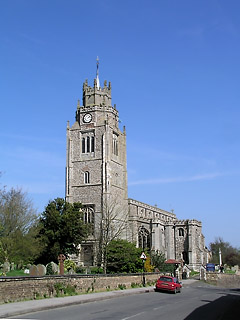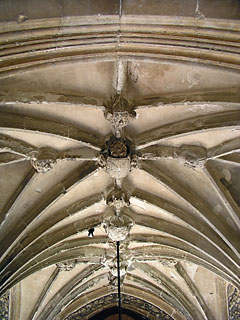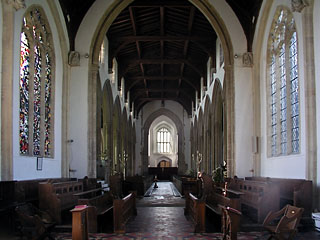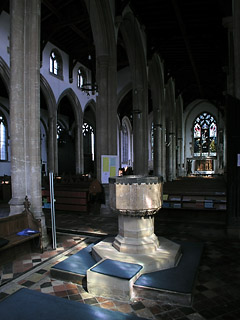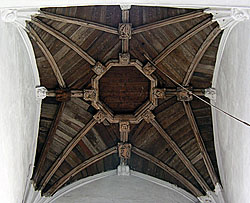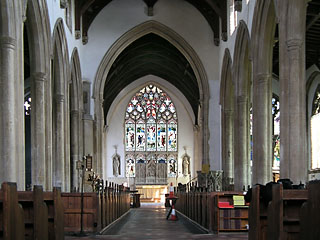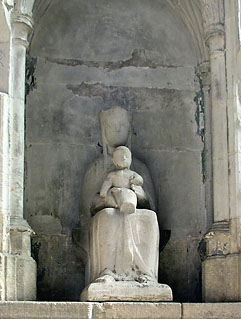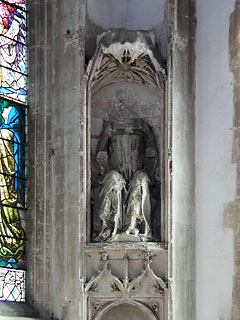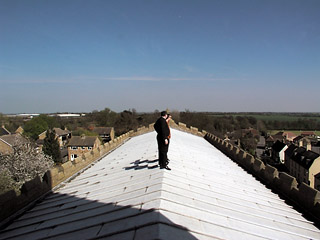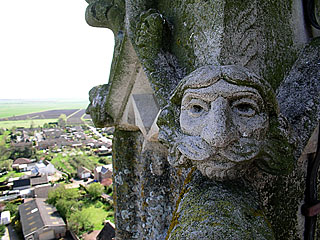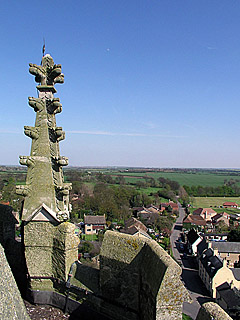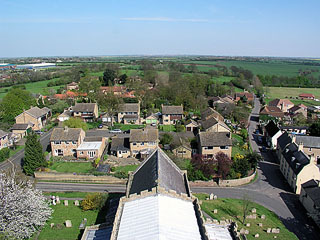St Andrew is one of the great churches of the Fens. Like all the medieval churches in this bit of the world, it was built on an 'island': the bumps of land that rose from amidst the drenched fens and provided a safe haven where the fishing folk could live, keep some livestock and worship. In the years that the Fens have been drained, of course, these 'islands' are now surrounded by miles and miles of flat fields. So intensive has been the farming of the Fens, the soil is now becoming exhausted and shrunken; this, along with rising sea levels, makes it seem likely that Sutton is going to end up being on an island again, maybe even in my lifetime.
Personally, I will welcome it, with a sort of bitter awe: the water rolling in and soothing the poor wounded earth, hiding from us the evidence of human hubris. And - save for the ridiculous Victorian villages in the bottoms, like Friday Bridge, most human habitation is high enough that it will survive. True, it will mean a great dislocation for many people, and it will mean that Britain loses its best farming land. When all that's done, though, some things endure. The islands will endure; St Andrew's will endure, and instead of being surrounded by the awful flat fields, it will be attended by a riot of eels, otters and marsh-birds.
Sutton's island is the same that Ely itself sits on, and so it is hardly surprising that St Andrew has enjoyed the patronage of the Abbots, and then Bishops, throughout its history. The present building dates from the latter half of the 14th century, mostly having been built by Bishops Barnet and Arundel. Especially on the south side, which looks down the high street and over the tiled roofs towards Grunty Fen, it is built of fine dressed stone, with battlements along the parapets. The appearance is made even richer and fortress-like by the small half-octagonal projections in the walls between the windows, which have projecting buttresses and are topped by little castellations in the battlements. The chancel lacks battlements, but has fine windows of three lights, with tracery in the tops forming a mitre-shape. The west window is especially grand.
The best bit of the exterior, though - and the most familiar, since it can be seen from miles around - is the west tower. This was the final part of the church to be built (Pevsner thinks that the bishops started at the east end, and worked their way west over the course of about thirty years: certainly the tracery in the windows seems to become more Perpendicular the further west one is looking). It rises in four stages, with clasp buttresses at the base, followed by octagonal buttresses on the second stage and intriguing diagonally-set cross buttresses on the third. On the bell-stage, these buttresses rise into four engaged pinnacles, framing the grand bell-openings which are set in carved stone panelling.
Crowning the bell-stage is an octagonal lantern - or, rather, two octagonal lanterns perched one atop the other, like a wedding cake. The lower one - which also contains a clock - has pinnacles rising in the middle of each face from the battlements, while the upper one has similar pinnacles in the corners. The whole thing is topped with a little spire.
The porch, unlike the nave and aisles on the south side, is built of fieldstones with dressed blocks reserved for the corner. It is, however, also buttressed, and very grand; there is a big doorway with battlemented capitals on either side, and a good stair turret leading up to what seems to be a parvise. Within the porch, there are stone benches along the sides, and there is a double vault by way of ceiling. It is pleasantly elaborate, rising like the fronds of a palm from pillars set against the north and south walls, and is covered with bosses. One shows a shield of the Trinity, attached to a ball of roses, while others depict women, bishops and beasts. Two have the shields of Bishops Barnet and Arundel.
A couple of steps lead up into the church itself. The interior is every bit as grand as the exterior would make one think: yet another demonstration of the powerful patronage of Ely. The nave has six bays, and the arcades are tall and elegant, composed of lozenge-shaped piers with attached shafts to the east and west. There are dripstops in the shape of animal and human heads on the moulding of the arches, and above the clerestory are larger corbels similarly carved into fantastical shapes (I think I saw some wodewoses in amongst the more familiar twisting animals).
The corbels support a broad timber roof, the age of which I found difficult to place. It might be medieval: certainly, the colour of the wood and the slightly uneven shape of it suggest as much. Whether or not it's medieval, it's still beautiful, with carving in the spandrels and in the spaces between the apex and the tie-beams.
The aisle windows are also unusually elaborate. They are all of a unified design - three lights, with early Perpendicular tracery in the tops - but they sit within very sparse blind arcading on the walls of the aisles, with a string course running all the way along just beneath window-level. It's similar to the way that St Peter at Wilburton is built, which is another great Fen church built under the patronage of the bishops; I wonder whether it was a house style?
The tower arch is surprisingly plain, given all this, though its great height makes it dramatic. The walls within the tower are filled with lots of monuments, and the space is topped with a modern wooden vault, framing an octagonal trapdoor. In the places where the ribs of vaulting cross, a number of wooden bosses seem to have been affixed - I wonder if they were older survivals? They are, like all the carving in the church, quite jolly: amongst other things, I counted a dragon, a dog, a winged lion and an angel.
What with the light from the west window, this is a nice space, and I was glad to hear from the vicar that the parish have plans to clear out this and the western part of the nave so as to give the parish a social space. Certainly, there's nothing to be lost by getting rid of some of the benches in the nave and aisles; there are some old poppyheads that have been affixed to modern benches, but those can easily be moved towards the east end of the church, and even in so prosperous a place as Sutton there can't ever have been enough people to fill the entire nave.
Up at the east end of the south aisle, there must once have been a guild chapel, for in the corner between the blind arcading on the east and south walls are two diagonal niches set one above the other. Both have remnants of their original paintwork, but they're in very different styles. The lower one is set into a square frame with two little ogeed arches in relief on the stone above it, and a tiny boss where they meet. It now contains a little image of the virgin and child, which was installed in the 1960s. We were told that it has been dated to before the Reformation, having been found buried when they were building new houses at the bottom of the village, but I don't think I believe it: the style is far too abstract and sparse.
The upper niche is grander, though it is also more damaged. Above it there remains some false vaulting, with more scraps of paint, but now there is nothing but a silhouette on the wall to indicate where there was once a tall spire attached to the canopy. Sitting in the niche are the battered remains of a life-sized seated male figure; unlike the Virgin below, this one looks like it might have been here the whole time.
After all the excitement of the nave, the chancel is a bit disappointing: the Victorian restoration here succeeded in making it all a bit bland (so, for example, the roof corbels here have been replaced, and aren't nearly as characterful). The side windows have interesting tracery, though, and the same blind arcading is used on the walls. The east window is especially fine, though the Victorian stone reredos projecting into its lower lights is an unwelcome distraction.
The window itself is composed of five balanced lights, which are topped with a little battlemented transom, above which the sober vertical lines blossom into a tremendous mass of curls and swirls. Pevsner dates it to about 1370, right on the cusp between Decorated and Perpendicular, and there's something of exuberant experimentation about the shapes here.
The glass here - and in most of the church - is uninspiring, but the south-westernmost window in the chancel makes up for it. This was installed in 1975, in memory of Arthur and Emily Mary Derby, and is a semi-abstract design in the style of John Piper. A big spire at the top is surrounded by fragments of colour, along with angels and crosses; a circle down below contains hints of wings of feathers, all in fine bright colours. Especially with the sun streaming in, it was a lovely sight.
While we were exploring, the vicar (Mark Amey) from whom Mark had borrowed the church key came along to chat to us about the church and village.
One of the pleasures of visiting churches is being able to talk to the people whose lives are presently twined through the buildings. Ancient churchwardens are my favourites, since they tend to have stayed in the village for longer than most vicars, though they sometimes start being a bit suspicious of a young man with bleached hair and a leather jacket wanting to take the church key, and need persuading that I don't intend to steal the candlesticks or smoke cannabis in the vestry.
The Rev. Amey at Sutton had moved up from my old stomping ground in South London, and talked to us about how he's been trying to revive the community within the village, which has suffered somewhat from being within commuting distance of Peterborough, Cambridge and London.
He also unlocked various doors for us, and gave us a tour of those bits of the church that we wouldn't normally be able to see. First, we got into the parvise. It was a bit grubby and cluttered, but was clearly once a surprisingly spacious priest's room, complete with fireplace. If it weren't for the fact that they need somewhere to store the assorted detritus (piles of oasis foam, signs for fairs saying 'Tombola!' and 'Raffle!' and 'Cakes!'), this could be an excellent chapel for private contemplation: over at Blythburgh in Suffolk they've done a similar thing with their parvise, and it works very well. It wouldn't make much sense unless they kept the church open for visitors, though.
Joy of joys, Mr Amey also took us up the tower. We wound our way up to the ringing chamber, which is a very high space filled at the top with a huge sixteenth-century timber bell-frame.
We climbed through this (excitedly in my case, perhaps a little more labouredly in the two Marks' cases) and emerged onto the lower stage of the octagon, whence we had gorgeous views out over the Fenland for miles around. In the foreground, we had a fine view down upon the village.
The vicar pointed out to us the original extent of the vicarage land, which covered much of a new sixties development to the north. The Georgian vicarage itself had originally taken up the area now filled with three sixties houses, but by the 1960s had fallen into such a state of disrepair that it had to be demolished. (Rev. Amey knows the daughter of the last vicar to live in the old building, and she told him that the advantage of the new house was that one didn't have to rig up tarpaulins over the beds to avoid getting showered with decaying plaster during the night).One of the new houses is the present vicarage, and the other two were sold.
One was, until very recently, inhabited by a retired headmaster, who sounds like something of a Heath Robinson character. One of his labour-saving contrivances was attaching his lawnmower to a post in the middle of the lawn, and then leaving it to run by itself while he sat and read the papers. It used to work, apparently (though it presumably cut the lawn in a spiral), but he abandoned the idea after it broke loose one day and tried to trim the dining room carpet.
It's a fine thing to be able to look down from a high place into peoples' back gardens, and houses, and to see the shapes of their lives. It's also a fine thing to look further, and look at the trails of smoke and the signs of habitation further off, and know that those places too are full of life, and of stories.
It wasn't an especially clear day when we were atop the tower at Sutton, so I couldn't make out the further places: I'm sure with better light and clearer air we could see as far as March and Littleport. Ely, of course, was visible, the cathedral lurking off to the east like a great crouching animal. And, all around, there were the flats, criss-crossed by straight roads and ditches.
Once again, I imagined the water coming in, and in my mind's eye I saw the regimented fields giving way to little muddy oozes full of frogs and fish, and the nests of wading birds.
St Andrew is open most mornings and there are notices of keyholders for other times.
